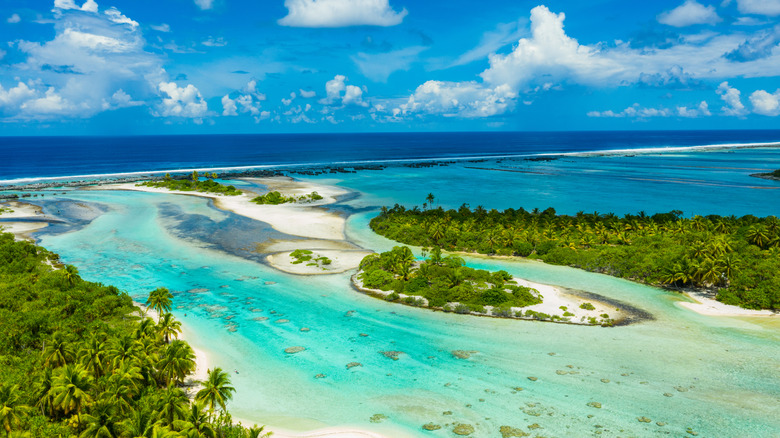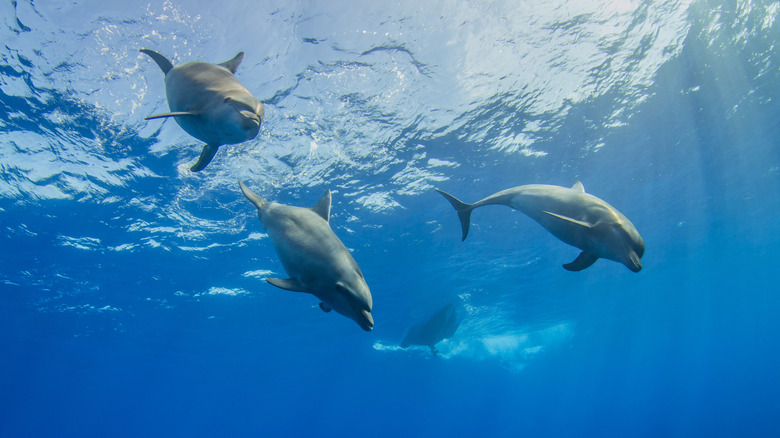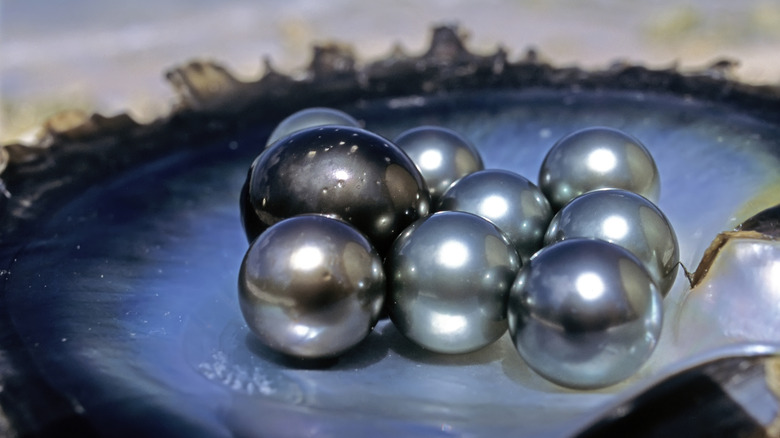French Polynesia's Largest Atoll Lagoon Is A Vast Tropical Aquarium Of Untouched Marine Life
If your dream vacation consists of swimming with manta rays, dolphins, and sea turtles above a vibrant coral reef in the turquoise waters of an endless lagoon, the swoon-worthy Rangiroa in the South Pacific might be the perfect choice. Located about 217 miles northeast of the bucket list-worthy Polynesian island of Tahiti, Rangiroa, with its nutrient-rich water, is a sanctuary for marine life and a paradise for underwater explorers, making it one of the top five diving destinations in the world.
Rangiroa, or "vast sky" in the local Tuamotuan language, is the largest lagoon atoll in French Polynesia and the second largest in the world. NASA took a stunning photo of Rangiroa from above, and it looks like a gigantic pearl necklace comprising over 240 coral islets spanning 110 miles of sea. In addition to the incredible sea life, it has postcard-worthy scenery of unspoiled beaches and motu — coral and sand islets with vegetation surrounding an atoll. Besides diving and snorkeling, Rangiroa has a few land-based activities like wine tasting, pearl shopping, and barbecuing.
The secluded paradise is only an hour's plane ride from Tahiti Faa'a International Airport. Air Tahiti offers direct flights from Papeete, the capital of French Polynesia, and Bora Bora, another famed French Polynesian island. The main tourist hub of Rangiroa is on Avatoru, where the airport and most of the accommodations are located.
The mecca for scuba divers
Many dive centers in Rangiroa offer PADI certifications, providing you with scuba diving basics. Tiputa Pass is known for its giant school of barracuda and jackfish on the west coast of the atoll. It's also where the endangered hammerhead sharks are known to traverse. Plan your trip between December and March to observe the magnificent creatures. Bonus: You will most likely be accompanied by curious and playful bottlenose dolphins during your underwater excursion.
Avatoru Pass is another world-class dive site. In addition to colorful fish and a thriving coral reef, you can often see manta rays, sharks, and stingrays. The strong currents are optimal for drift diving and especially fun for experienced divers. If you're island-hopping around French Polynesia by plane, avoid flying right after scuba diving. Wait 12 hours before venturing to your next destination to prevent decompression sickness (DCS), also known as "the bends."
If you don't want to scuba dive, you can still experience the magical underwater scenery through snorkeling. If you are staying at a beachfront property, you can easily snorkel in the lagoon on your own. Alternatively, you can arrange a tour — many tour operators can take you to some of Rangiroa's most vibrant and colorful coral reefs and their astounding residents. The most epic spot for snorkeling is "The Aquarium" — an islet at the end of Tiputa Pass where the robust coral reef comes right up to shore. It's a protected area where you can glide over the reef and visit with many colorful fish, eels, and reef sharks.
Experience the gorgeous Rangiroa by land
One of the most surprising things about Rangiroa is that it has a winery! Domaine du Domique Auroy is the world's only vineyard on a motu, producing delicate white wine and rosé. Its distinct geography and the quality of the vino have gained a cult following. Be sure to tour the vineyard and its cellars and taste the refreshing wines you can take home. If you prefer something beyond wine, try Mana'o Rangiroa.
Another treasure from Rangiroa is the famous Tahitian pearls. Gauguin's Pearl is a reputable pearl farm with sustainable and ethical cultivation techniques that support the environment and local community. Its pearls are certified and graded for quality, so you can be certain you're bringing home an authentic and genuine pearl. You can also join a fascinating and enriching guided tour to learn how oysters produce cultured pearls.
While Avatoru is the tourist hub, the village is in Tiputa, where the locals live. If you befriend your host or a local, you might be invited to join a feast of Polynesian barbecue and hula dance. The local cuisine depends on fresh seafood and local produce with an exotic blend of various flavors. Enjoy poisson cru, a raw fish salad marinated with citrus fruit and coconut milk, with a side of crudités, freshly sliced vegetables with dip, and paired with a glass of Polynesian white wine — a divine and unforgettable meal. Can't get enough of the stunning French Polynesia? Head to Tahiti's "sister island," the uncrowded Moorea, for more luxurious views and turquoise waters.


